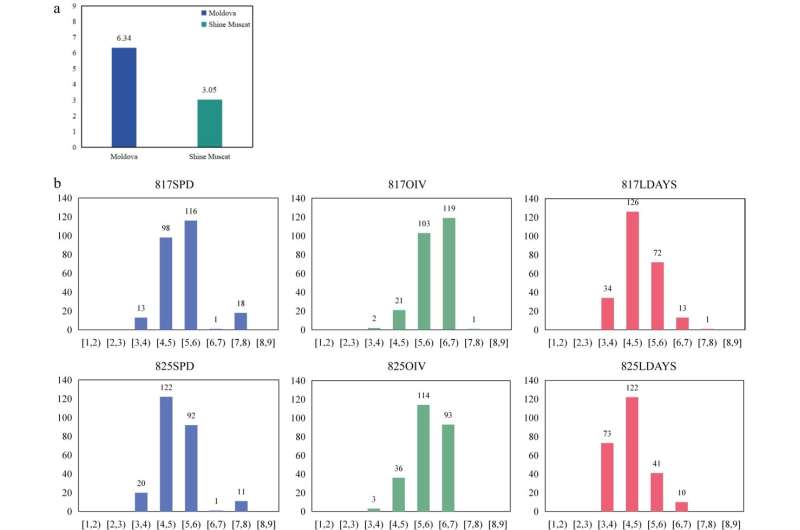This article has been reviewed according to Science X's editorial process and policies. Editors have highlighted the following attributes while ensuring the content's credibility:
fact-checked
proofread
Rpv34: A novel plasmopara viticola resistance locus discovered in 'Moldova' grapes

A research team identified a P. viticola-resistant locus, Rpv34, in table grapes through analysis of a high-density genetic map with 826 SNPs derived from F1 progenies of "Moldova" (resistant) and "Shine Muscat" (susceptible parent). This discovery, including the identification of 21 Resistance Gene Analogs and a highly associated SNP marker, enhances understanding of resistance mechanisms and supports the breeding of resistant grape varieties, which may improve grape quality and production.
Grapevine cultivars, primarily derived from Vitis vinifera, are highly prized for their aroma and flavor. However, they are also susceptible to diseases like downy mildew. While current research indicates that fungicides are commonly used for the control of P. viticola, they lead to pathogen resistance, high costs, and environmental issues.
Furthermore, the traditional breeding method cycle is long and imprecise. Most quantitative trait loci (QTLs) for downy mildew resistance originate from inferior quality varieties, which complicates the breeding process.
A study published in Fruit Research on 2 July 2024, aims to address these issues by using marker-assisted selection (MAS) to identify and validate P. viticola-resistant QTLs, thereby facilitating the development of high-quality, resistant grape cultivars.
In this study, the phenotypic analysis, genetic mapping, QTL mapping, genome-wide association study (GWAS) analysis, and joint analysis were utilized to identify and validate resistance loci for P. viticola in grapevines. In phenotypic analysis, the female parent "Moldova" showed resistance with an average score of 6.34, while the male parent "Shine Muscat"was more susceptible with a score of 3.05. The progenies displayed a continuous variation in resistance, indicating a quantitative trait distribution.
A high-density genetic map was constructed using 826 heterozygous mSNPs, spanning 1,515.99 cM. QTL mapping identified a resistance locus, Rpv34, on chromosome 18. GWAS analysis further validated these findings. Combining these methods, 21 RGAs were identified within the target region. The SNP marker chr18_29062596 was found to be highly correlated with resistance, showing significant reproducibility across multiple phenotypic analyses.
According to the study's lead researcher, Bin Han, "This work will improve the mechanism of resistance understanding of P. viticola in grapevine and facilitate the use of resistant germplasm in breeding."
In summary, this research identified the P. viticola resistance locus Rpv34 on chromosome 18 in grapevines. The F1 progenies from "Moldova" and "Shine Muscat" were assessed, revealing a key SNP marker, chr18_29062596, highly correlated with resistance. These findings enhance understanding of grapevine resistance mechanisms and aid in developing disease-resistant cultivars, promoting sustainable grape production.
More information: Yan Sun et al, Rpv34: the noval Plasmopara viticola resistance locus in 'Moldova', Fruit Research (2024). DOI: 10.48130/frures-0024-0017
Provided by Maximum Academic Press




















